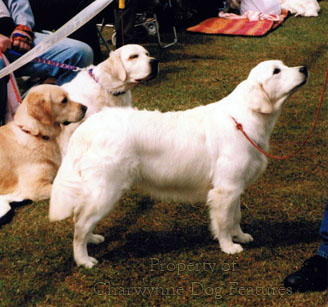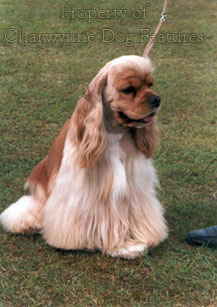197 ENDORSED ANARCHY OF DOG BREEDING
THE ENDORSED ANARCHY OF DOG BREEDING
by David Hancock

 In ancient times, it was perhaps easier to ascertain why dogs were bred. With the threat from wolves to domesticated animals, no firearms to kill game from a distance, roving bands of robbers and freezing nights in uncentrally-heated dwellings, it is easy to justify how flock-guarding, arrow-retrieving, deer-catching, house-protecting and warmth-providing dogs could be valued and then perpetuated. But the biggest single reason for the remarkable development of so many breeds was man's love of sport, from the Greeks in classical times to medieval Bavaria and beyond.
In ancient times, it was perhaps easier to ascertain why dogs were bred. With the threat from wolves to domesticated animals, no firearms to kill game from a distance, roving bands of robbers and freezing nights in uncentrally-heated dwellings, it is easy to justify how flock-guarding, arrow-retrieving, deer-catching, house-protecting and warmth-providing dogs could be valued and then perpetuated. But the biggest single reason for the remarkable development of so many breeds was man's love of sport, from the Greeks in classical times to medieval Bavaria and beyond.
Sportsmen in country areas all over Europe have long taken their pursuit of game extremely seriously. Duke Ulrich of Wurttemburg made an order in 1517 which read: "Anybody, whoever it may be, met with a gun, crossbow or simila20r weapon in the duke's forests and hunting grounds, in woods or fields or any place where game may be about, away from public roads, or is seen to move in a suspicious way, even though he is not in the process of shooting, will have his eyes gouged out." In the same year, the zealous duke had a poacher sewn alive into the skin of a stag and coursed by his hounds.
This rather serious approach to hunting and shooting led to enormous and enormously-varied bags being accounted for each year. In one year, 1669, the following were offered for sale from the Elector's store in Dresden old town: 861 red deer, 616 wild boar, 646 hares, 751 partridges, 65 woodcock, 20 Indian geese, 4 swans, 15 bears, 74 wolves, 15 lynxes, 170 foxes, 55 badgers, 17 beavers, 27 otters and 13 squirrels. Could such a total have been achieved without the help of dogs? Could this have been achieved without the help of dogs bred for a specific purpose?
The combination of a passion for hunting by noblemen in Europe and the wide range of prey led to the development of most of our contemporary sporting dogs: hounds, setters and pointers, with functional excellence being the sole criterion; no sign of any obsession with bend of stifle, level topline or length of ear. When my eye is attracted to a statuesque over-furnished English setter posing in a gundog class at a conformation show, I, almost in sadness, ponder the rich heritage behind this splendid breed. I recall the superb field dogs run by the late Dr. J.B.Maurice from his "Downsman" kennel; the extraordinary field trial record of William Humphrey and his "Windem" line of Llewellins; Llewellin himself and his superbly-bred dogs; Laverack and his handsome yet functional dogs -- then think back to the chien d'oysel of medieval times.
I can remember seeing the impressive langhaar for the first time -- thinking at a distance, in my ignorance, that it was an Irish setter. I recall too the admirable small Munsterlanders I saw in Westphalia thirty years ago -- so much like the Llewellins in their working style. We now own thousands of German short-haired pointers but breed few langhaars and no small Munsterlanders here at all. Is this from ignorance, prejudice, personal preference or a copycat mentality?
Preferences in the show ring, although preserving some breeds which would have otherwise been lost to us like the Irish wolfhound, the field spaniel and the Dandie Dinmont terrier, have led to the removal of much of the rich variety in our setter breeds. For whilst only the field fraternity in the United States persevere with the Llewellins, we have lost the Llanidloes variety, the tricolour of Southesk, the jet-blacks of Ossulton and Mr. Lort's black and whites. In this context the renaissance of the red and white Irish setter is more than welcome. A litter of setter pups a hundred years or so ago could contain six different colours or colour combinations.
The performance and stature -- in every sense of the word -- of the superb black and white Gordon setter owned and trialled by Bob Truman, which has been described as the best grouse dog this century, could be of enormous value to the breed. But such outstanding genes will never be capitalised on beyond the shooting field; colour prejudice will nearly always triumph over sheer merit. But are we that happy with the quality in the breed? I see some quite shocking specimens as pets. Do we breed for real quality in our pedigree breeds or just want to win rosettes?
Our sporting ancestors gave us these magnificent breeds as functional animals with a clearly identifiable type to each breed. In some breeds this heritage is handed on to us even in the breed name, as exemplified in the golden retriever and the yellow labrador. In the latter, the public may not notice the thin coats but they cannot but help notice the absence of yellow in increasing numbers each year. I seem to see more "golden" retrievers resembling Maremma sheepdogs too every show season. Where is that wonderfully attractive red-gold hue of old? If present-day breeders are not skilful enough to breed the correct colour for their chosen breed, then they should choose another breed -- and not be allowed to alter the breed standard when they lose a breed feature. Why be contented with pale imitations? Why abandon treasured coat colours handed down to us by the pioneers in a breed whom we claim to revere?
I often hear contemporary breeders of pedigree dogs state quite shamelessly that their terriers aren't expected to "go to ground", that their bulldogs aren't going to need to "pin" bulls, that their great Danes will never be called upon to hunt wild boar and that their Gordon setters don't have to last a long day on a grouse moor. That to me is a quite shocking abrogation of responsibility. We should be proud of breeding dogs which are still capable of carrrying out their original function even if they will never be required to do so. 
In that way we keep faith with those we record reverently in our breed histories. In that way we honour the heritage of the precious breeds we have the privilege of owning in our lifetime. Just as they were handed down to us, we in turn have to hand them down to those who come after us. We should be able to do so both with a clear conscience and immense inner satisfaction not with silent regret and concealed embarrassment. But who is going to act as breed-guardian when breeding accidentally produces an undesired result or when a misguided clique try to dominate the thinking over the essential type in a breed? At the turn of the century it might have been a member of the aristocracy standing firmly behind the value of heritage and a noble desire to honour inheritance without financial advantage; not any more. Breed societies and the respective councils have a key role, with the Kennel Club having the self-set role as keeper of the written blueprint for each and every pedigree breed. By itself, that is not enough. Breeders perpetuate a breed; breed clubs need to act corporately and act as a guardian for their breed.
Are we breeding to suit breeder-whim or because we wish to sell our stock even if it doesn't match our particular breed's characteristics? If the former, why is it being condoned? Who's in charge? If the latter, how dare any one destroy a breed in this way and get away with it! I can understand different readers interpreting any breed standard in individual ways quite innocently. But there is nothing innocent when crystal-clear, totally unambiguous direction is provided -- and then brazenly ignored by both breeders and exhibitors...and then judges in their turn. Sounds like a conspiracy -- or defiance!
In the breed standards of the gundog group for example: the field spaniel is required to have its tail docked by 1/3rd; all the fields I see have their tails docked by 2/3rds. Forget the docking dilemma for a moment -- is there anything ambiguous about this part of the field spaniel's breed standard? The cocker spaniel's ears are described as "extending to nose tip". I see exhibits from this breed winning with ears long enough to wrap around the tip of the dog's nose. The American cocker spaniel is expected to have ears extending to its nostrils; those I see in the show ring have ears way way beyond the dog's nostrils.
In the hound group, the beagle is supposed to have ears "reaching nearly to end of nose when drawn out". Is it not an expectation therefore for the beagle's ears to be only very slightly shorter than a cocker spaniel's. That can be the only interpretation of the blueprints for the breeds concerned. But we all can see that in reality this is not so. The bloodhound is required to have eyes which are not sunken; go to the ring for this breed at the next show and you will see a high proportion of the bloodhound entry with sunken eyes. How can the fanciers of these breeds claim to have the best interests of their breed at heart when they are knowingly breaching the agreed blueprint for that breed? What are these breeders breeding for? It cannot be for accuracy or breed-loyalty.
I believe we should be breeding our pedigree breeds of dog to honour their ancestry, acknowledge their function, preserve type and perpetuate their key characteristics breed by breed. Every novice in the showdog scene is directed to study the breed standard as the first step in his or her induction to the chosen breed. Most show critiques refer to it. Yet when I advised a potential pointer owner to go to Crufts a few years ago and take the breed standard with him, he rang me later in some confusion. The pointer breed standard states that dogs on the move should definitely not display a hackney action. My colleague saw a pointer not only win its class with a hackney action but win the gundog group as well!
What all this adds up to is a lack of authority in the dog show world, nothing less. I can see no sign of a determined, enlightened, informed individual with the personal stature to sort this situation out. Perhaps we need a wealthy patron with the single-minded zeal of Duke Ulrich of Wurttemburg, if not his barbarous method, to bring some much needed authority to the dog game. If we degrade function, ignore blueprints and dismiss breed-purpose for much longer, we could harm the essential type of some breeds irretrievably.
Just over one hundred years ago, the great setter man Edward Laverack was writing: " The first thing to be attended to in breeding is to consider what object the animal is intended for...One of the first objects to obtain if possible is perfection of form as best adapted for speed, nose and endurance. The next and which I consider paramount...is an innate predisposition to hunt and point naturally in search of game and without which innate properties mere beauty of colour and perfection of external form are but secondary considerations to practical sportsmen and simply valueless". Now there's a man we can all respect -- and we ignore his words with massive irresponsibility and great foolishness.